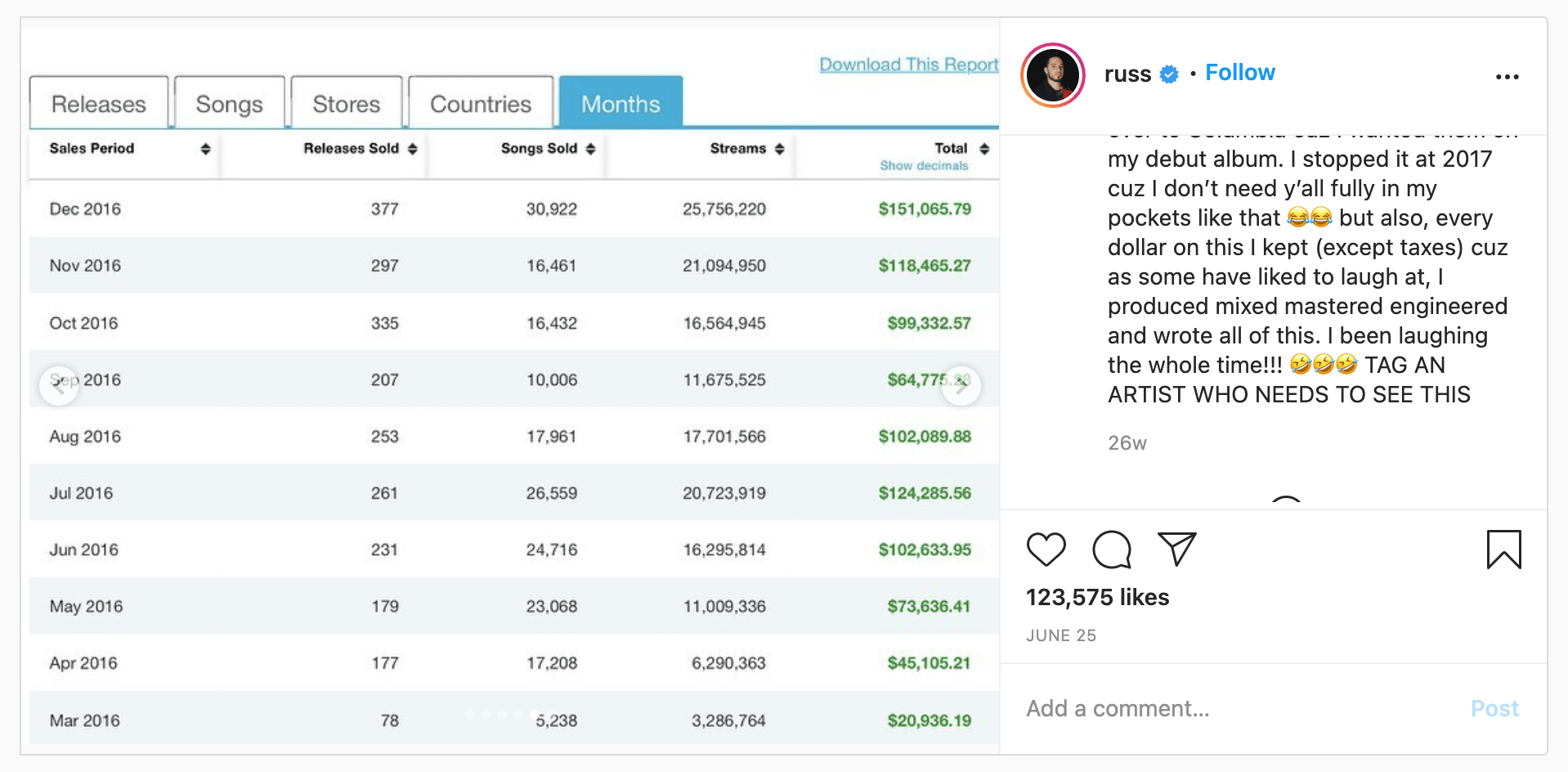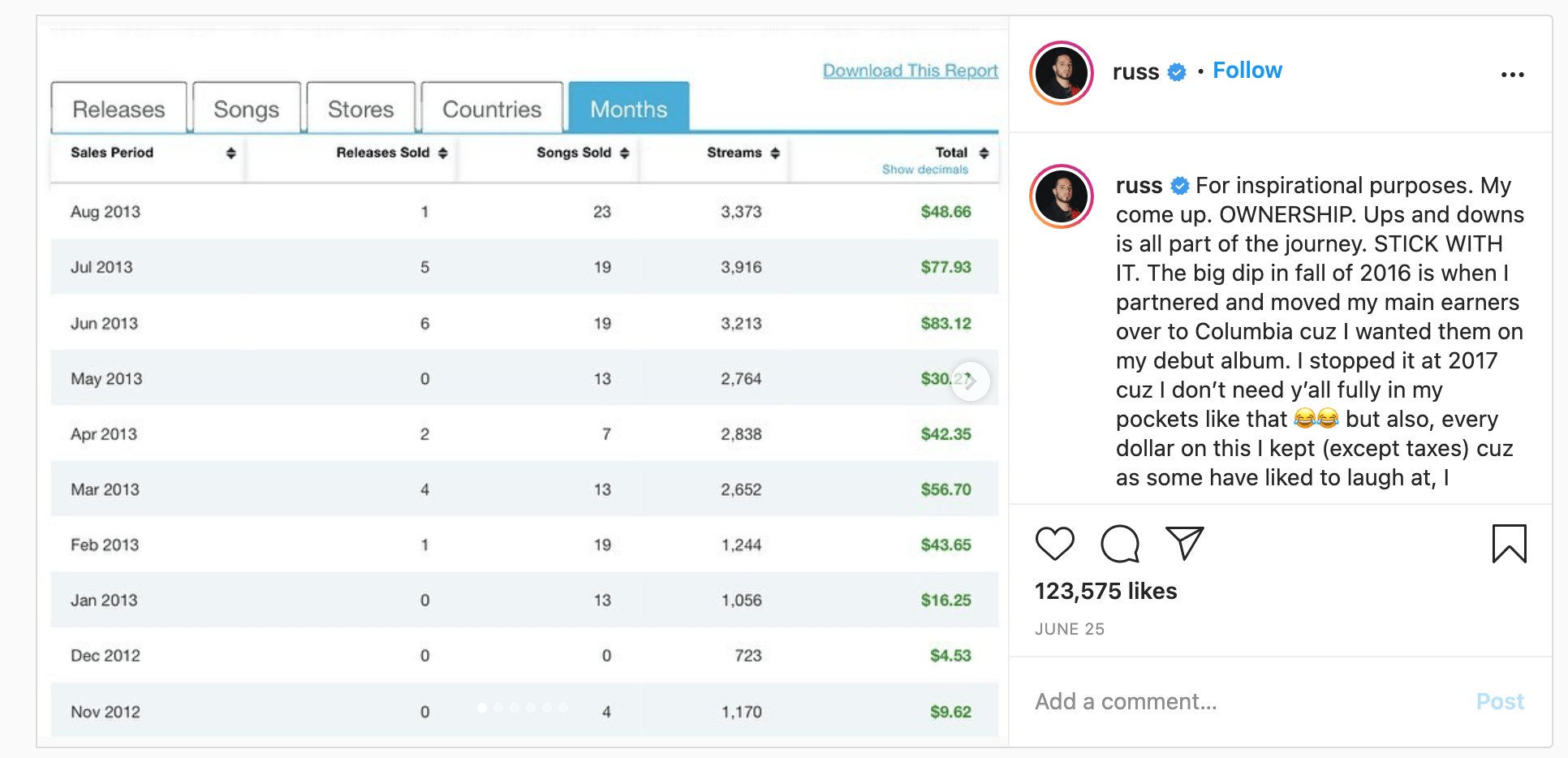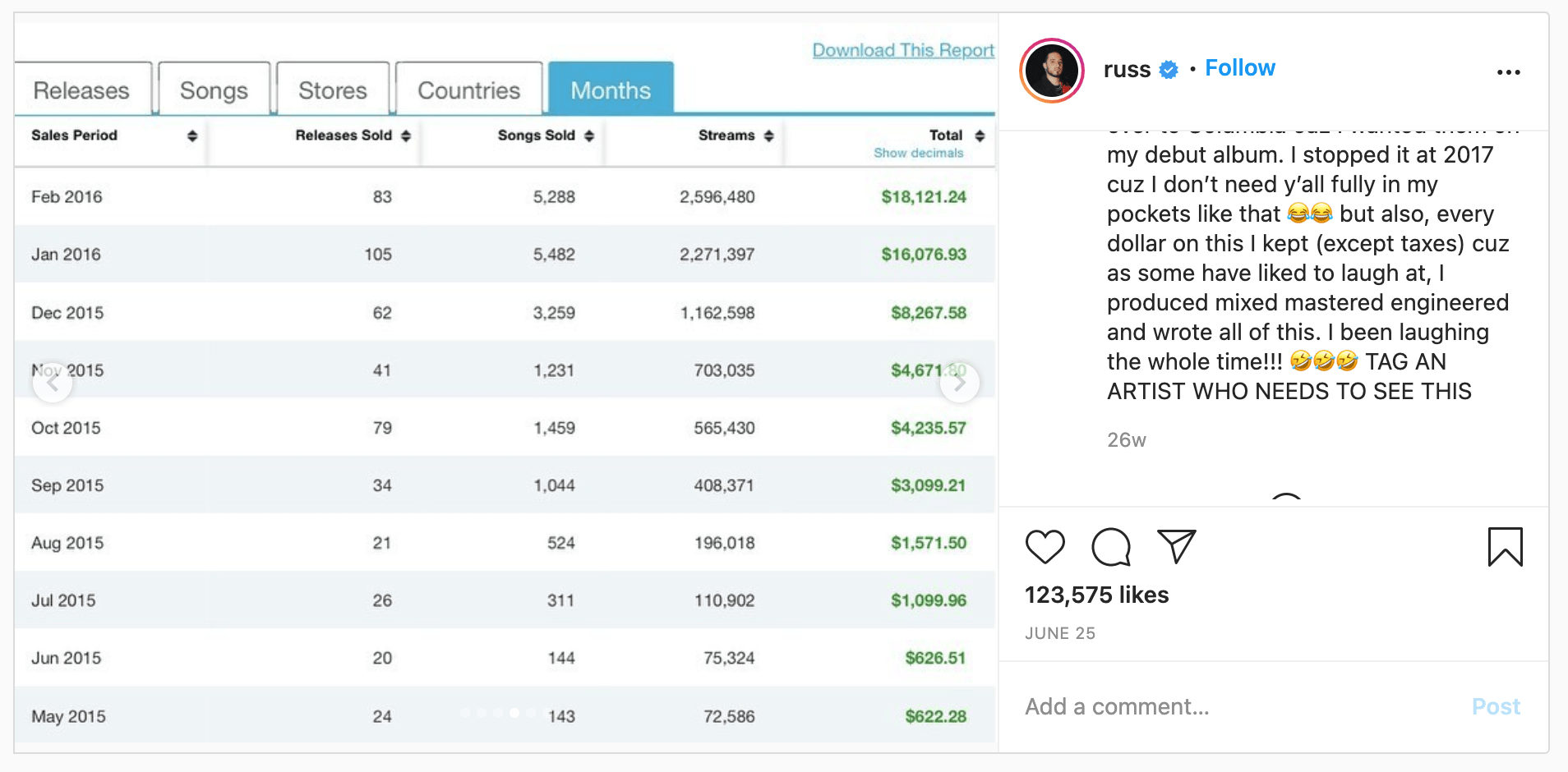Russ is a bona fide superstar. So when he casually shared pages and pages of his music income statements from TuneCore on Instagram, a lot of artists and industry jumped on the post.
The Atlanta-based rapper is one of the biggest champions of maintaining independence as an artist — even as he signed a deal with Columbia Records in 2017. In June 2020, Russ completed the terms of that deal and pretty much immediately shared his royalty statements from his first release up until that major deal.
As of November 2020, Russ is once again releasing music fully independently (as the 288th most-streamed artist on Spotify). Here are a few of many takeaways we can learn from Russ' Instagram post and beyond.
1. Ownership Is Key
If there's ONE major thing all content creators need to learn, it's that the person who owns the content gets paid the most. One of the major reasons Russ even had the ability to share his TuneCore statements is that he owned the content being shared. In his post, Russ mentions that he had a big dip in September and October 2016. That's because he wanted some of his biggest songs to be on his major label debut — but he quickly changed his mind when he saw just how much money the label was going to make off those songs (despite not adding any immediate value).
His earnings notably declined nearly 40% (and $40,000) in one statement. When he brought the songs back into his independent catalog, his revenue growth resumed. In a separate post in May 2020, he showed how two of his independent songs have individually amassed more than $1 million each.

Notice the two statements where Russ' income dropped significantly due to the label taking ownership of them
2. Russ Wasn't Making Enough Money To Sustain Himself For The First Three Years
Content creation is a long game. It takes consistency and strategy, and if you're the type of person who gives up if they haven't "made it" after a year, content creation just isn't the gig for you.
From November 2012 through August 2015, Russ wasn't making enough money every month to reasonably maintain a standard of living from his music. In September 2015, he eclipsed $3,000 per month for the first time — nearly three years after he started releasing music.
In fact, Russ didn't even make over $100 in a month until after about 15 months of releasing music.

For a while, Russ was probably barely breaking even on distribution fees — making a career from content isn't for the impatient
3. The Ability To Make Stuff Quickly and Cheaply Has Never Been More Important
Russ infamously released a song a week for nearly two years. He's prolific, but his genre (rap) also lends itself to fast turnarounds and lots of collaboration. A mix of determination and increasing access to studio-quality production at home meant Russ likely spent next to nothing on creating his music in the end (after costs for things like a computer, microphone, audio interface, plugins, and software instruments, which you can reasonably achieve for less than $3,000 total).
You don't have to release stuff as frequently as Russ — or even 1/10 as frequently as Russ — but you simply can't let a lack of content slow you down. Whether you're making YouTube videos, music, articles, etc. — you have to make it. And often. Now more than ever, being a full-time creator means investing in:
1) Equipment to make content at will
2) Education to understand how to use the equipment
3) Collaboration to work with people whose strengths complement your weaknesses and vice versa
Put simply, if it costs you thousands (or even hundreds) of dollars to create a single piece of content in your early days, you're putting yourself at a severe disadvantage.
4. There's A Correlation Between Streams And Downloads
It's honestly uncanny how downloads correlate to Russ' streaming numbers. Almost without exception, when streams go up, so do downloads. And when streams go down? Yep, downloads are down, too. Not only that, but there's a general percentage increase/decrease range in which the two numbers correlate.
When Russ' streams started to double in his early days, so did his downloads. Even smaller changes when he was doing significantly more streams and downloads seem to follow the trend. Interestingly enough, the number of albums sold seems to be both low and consistent compared to the number of singles and streams.
Now, correlation doesn't equal causation. Maybe there's an outside promotional factor that affects overall consumption.
But if you have a few years worth of data at your disposal, you should take a look and see if your downloads correlate to your streams. Are things different now in 2021? Possibly — this data is about three years old, after all. But at the end of the day, people are still downloading songs (especially internationally), even as streaming leads music growth. In other words — don't make it difficult for people to buy your music if they still prefer that. After all, the average premium Spotify user needs to listen to one of your songs about 175 times to equal how much you'd make from one iTunes download. That's like once a day for half a year. Which, if you've ever examined your own listening habits, is a lot.
5. "Hockey Stick Growth" In Independent Content Creation Is Real — Thanks To Technology
"Hockey Stick" growth basically means your "growth graph" looks like a hockey stick — it's plodding along slow and steady for a while before an event (or events) trigger a sharp incline in growth that then stay steady. One of the main principles of this kind of growth is that it doesn't suddenly drop or endure drastic ups and downs. Russ released around 300 songs independently, and for the first several years of releasing music he didn't see anything crazy in terms of growth; then within, a matter of about 5 months, he experienced 16x growth in monthly income (from about $1,000 to $16,000).
While Russ may be a particularly noteworthy example, we see this kind of growth increasingly in content creation. A creator will be toiling away for years, right up until the point where content catches fire and they see drastic, life-changing growth that typically evens off, but stays consistent and reliable. This type of growth wasn't really possible without massive marketing campaigns prior to the emergence of streaming services, YouTube, and Twitch etc.

The end of 2015 and beginning of 2016 was when Russ finally saw the "hockey stick" bend upwards drastically
These are just a few of dozens of possible takeaways. Russ has never been shy about his early struggles, his growth, or his desire to take charge of his own business. Hopefully, as more and more creators realize you don't have to choose between being good at art and being good at business, we'll continue to see creators speak up about their own struggles and successes.
